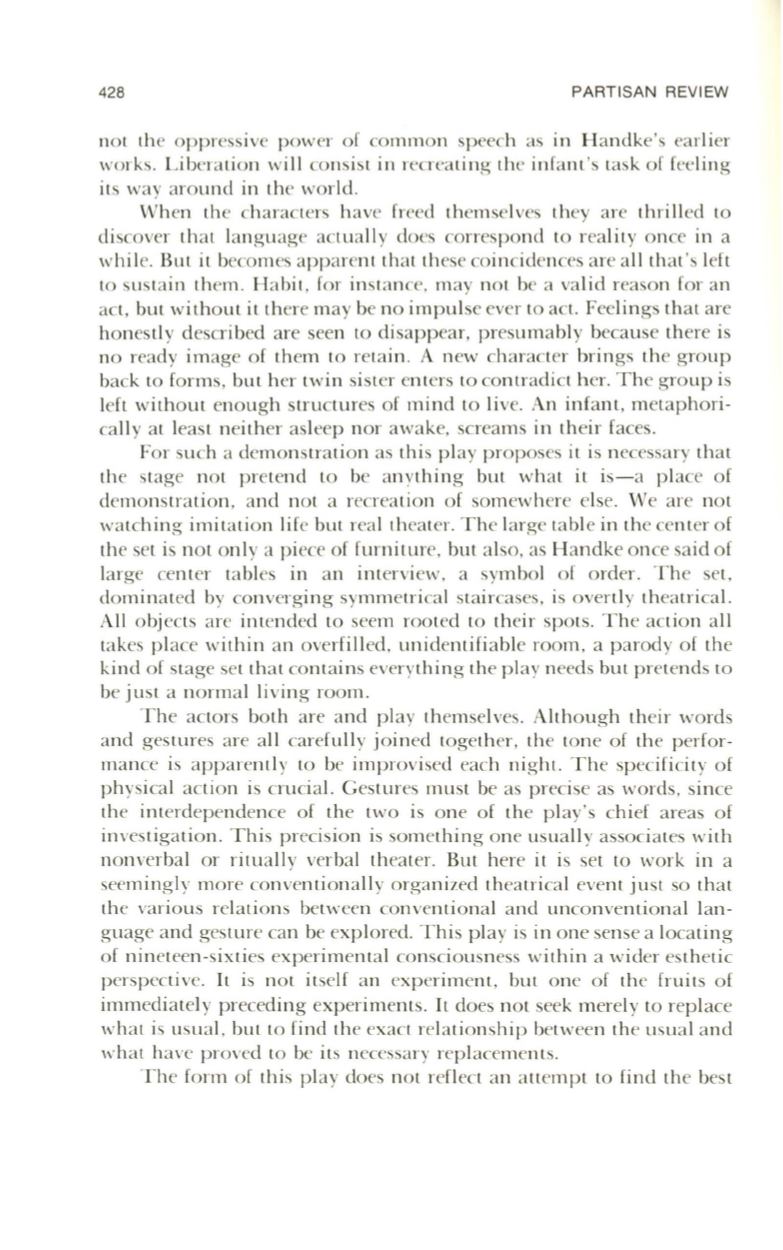
428
PARTISAN REVIEW
no t the oppress ive power of common speech as in H andke's earli er
wo rks. Libera ti on will consist in recrea ting the infant 's tas k of fee lin g
its way around in the world .
When the characters have freed themselves they are thrill ed
to
di scover tha t language actua ll y does corres pond to reality once in a
whil e. But it becomes appa rent tha t these co incidences are a ll tha t's left
to
susta in th em. Ha bit, fo r instance, may no t be a va lid reason for an
act, but without it there may be no impul se eve r to act. Feelin gs tha t are
hones tl y d escribed are seen to di sappea r, presuma bl y because there is
no ready image of them
to
retain . A new cha racter brings th e group
back
to
forms, but her twin sister enters to contradi ct her. The group is
left witho ut eno ugh structures of mind to li ve. An infant, metapho ri–
call y at leas t neither as leep no r awa ke, screams in their faces.
Fo r su ch a demonstra ti on as thi s play proposes it is necessa ry tha t
the stage no t pretend to be anythin g but wha t it is-a pl ace of
demonstra ti on , and no t a recrea ti on of somewhere else. We a re no t
wa tchin g imita ti on life but rea l thea ter. The la rge tabl e in the center o f
the set is no t onl y a p iece of furniture. but a lso, as Handke once a id o f
large center ta bl es in an interview, a symbo l o f o rder. T he se t,
domina ted by convergin g symmetri ca l sta ircases, is overtl y thea tri ca l.
All o bj ects a re intended to seem roo ted to their spo ts . Th e acti on a ll
ta kes pl ace within an overfill ed, unidentifi a ble room , a parody o f the
kind of stage set tha t conta ins every thing the pl ay needs but pretends to
be just a no rma l li ving room.
The acto rs bo th are and pl ay themse lves. Altho ugh their words
and ges tures are a ll carefull y jo ined togeth er, the tone of th e perfo r–
mance is a ppa rentl y to be improvi sed each ni ght. The spec ifi cit y of
ph ys ical acti on is crucia l. Ges tures must be as precise as words, since
the interdependence o f the two is one of the p lay's chi ef areas o f
in ves ti ga ti o n. This precision is something one usua ll y assoc ia tes with
nonverba l or ritua ll y verbal thea ter. But here it is set to wo rk in a
seeming ly mo re conventi ona ll y o rga nized thea tri ca l event just so tha t
th e va ri ous rela ti ons between conventi ona l a nd unconventiona l lan–
g uage and ges ture can be expl o red . T hi s pl ay is in one sense a loca tin g
o f nineteen-sixties experimenta l conscio usness within a wider es theti c
perspect ive. It is no t itself an experiment , but one of the fruits of
immedi a tely preceding experiments.
It
does no t seek merely to repl ace
wha t is usua l, but to find the exact rel a ti onship between the usua l and
wha t have p roved to be its necessa ry repl acements.
The fo rm of thi s p lay does no t refl ect an a ttem p t to find the bes t


